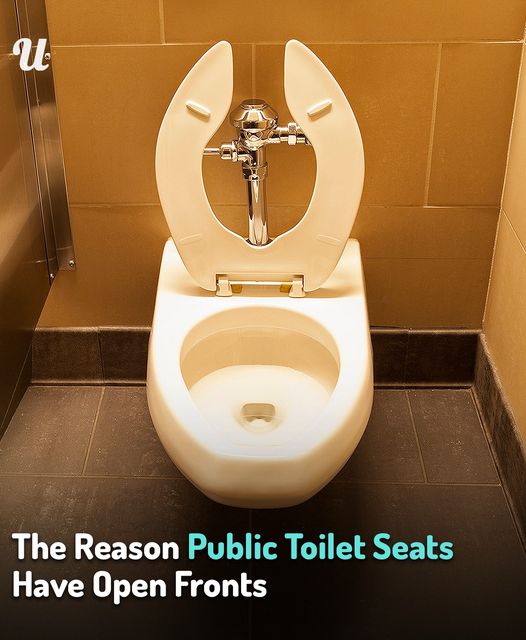
 The design of toilet seats may seem like a mundane topic, but the shape of these seats can invoke curiosity and even controversy.
The design of toilet seats may seem like a mundane topic, but the shape of these seats can invoke curiosity and even controversy.
 Most toilet seats you will encounter are ovular, but occasionally, you’ll come across a U-shaped design with an open front.
Most toilet seats you will encounter are ovular, but occasionally, you’ll come across a U-shaped design with an open front.
 While it’s common in public restrooms and some residential bathrooms, the reasoning behind its design has often been unclear.
While it’s common in public restrooms and some residential bathrooms, the reasoning behind its design has often been unclear.
Until now.

Toilet seat designs have evolved significantly over the years, adapting to changing societal norms and technological advancements.
The open front toilet seat, or ‘split seat,’ has been in use since the late 19th century.
 Originally, these seats were designed for use in public facilities, particularly in schools and hospitals.
Originally, these seats were designed for use in public facilities, particularly in schools and hospitals.
In the United States, open-front toilet seats are particularly prevalent in public facilities, and this choice isn’t merely about cost-cutting.
 The American Standard National Plumbing Code (ASNPC) established guidelines for public restroom seats in 1955, How Stuff Works reports.
The American Standard National Plumbing Code (ASNPC) established guidelines for public restroom seats in 1955, How Stuff Works reports.
They stated: “Water closets shall be equipped with seats of smooth non-absorbent material. All seats of water closets provided for public use shall be of the open-front type.”
 This regulation contributed to the popularity of open-front toilet seats in the US. By 1973, the International Association of Plumbing and Mechanical Officials (IAPMO) advocated for the broader use of U-shaped seats.
This regulation contributed to the popularity of open-front toilet seats in the US. By 1973, the International Association of Plumbing and Mechanical Officials (IAPMO) advocated for the broader use of U-shaped seats.
While there’s no mandate for all public toilets to adopt this design, some hygiene advantages are associated with it.
They were introduced as a hygienic solution to reduce direct contact with surfaces, which was especially crucial in high-traffic areas.
The design aimed to minimize the transfer of germs and provide a more sanitary experience for users.

 Yep, one of the primary reasons for the open-front design is hygiene.
Yep, one of the primary reasons for the open-front design is hygiene.
Traditional toilet seats can trap bacteria and other pathogens, especially if the seat does not fit snugly against the toilet bowl.
 Open front seats eliminate the potential for contact between the seat and the user’s body, thereby reducing the risk of contamination.
Open front seats eliminate the potential for contact between the seat and the user’s body, thereby reducing the risk of contamination.
This design is particularly beneficial in public restrooms, where the turnover rate of users is high, and the likelihood of spreading germs increases.
 Moreover, the open front allows for easier cleaning. Janitorial staff can access the area around the bowl without obstruction, ensuring a more thorough cleaning process.
Moreover, the open front allows for easier cleaning. Janitorial staff can access the area around the bowl without obstruction, ensuring a more thorough cleaning process.
In terms of hygiene, both men and women can benefit from this design since it eliminates a section of the seat that could easily be exposed to splashes or errant sprays.
 The gap facilitates easier cleaning for women and removes the part of the seat that a man’s anatomy is likely to come into contact with when adjusting himself.
The gap facilitates easier cleaning for women and removes the part of the seat that a man’s anatomy is likely to come into contact with when adjusting himself.

Another significant advantage of the open-front design is its accessibility.
 For individuals with mobility issues, including the elderly or those using wheelchairs, the open front provides a clearer path for transferring from a wheelchair to the toilet.
For individuals with mobility issues, including the elderly or those using wheelchairs, the open front provides a clearer path for transferring from a wheelchair to the toilet.
The absence of a solid front allows users to position themselves comfortably, promoting safety and independence.
 In addition to aiding those with disabilities, the open-front design can also prevent accidents.
In addition to aiding those with disabilities, the open-front design can also prevent accidents.
It reduces the risk of users bumping against a solid seat, which can be particularly important in crowded restrooms or for children who may not be fully aware of their surroundings.
 In a 2013 interview with Slate, IAPMO representative Lynne Simnick explained that the gap in the front allows women ‘to wipe the perineal area after using the water closet’ while minimizing the risk of their hands touching the seat.
In a 2013 interview with Slate, IAPMO representative Lynne Simnick explained that the gap in the front allows women ‘to wipe the perineal area after using the water closet’ while minimizing the risk of their hands touching the seat.
But since the oval shape is more commonly found in homes due to its comfort, there’s an expectation that you can maintain your own toilet to an acceptable level of cleanliness.
